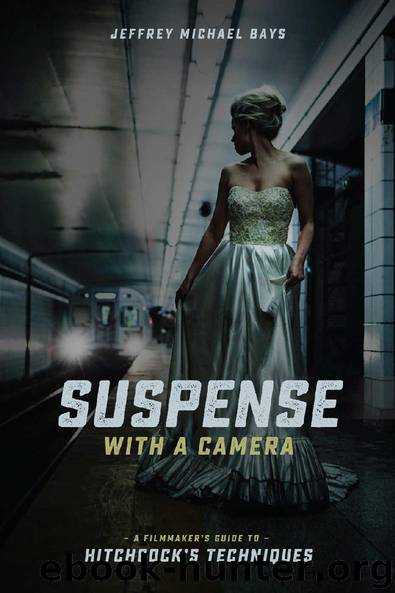Suspense with a Camera: A Filmmaker's Guide to Hitchcock's Techniques by Jeffrey Michael Bays

Author:Jeffrey Michael Bays [Bays, Jeffrey Michael]
Language: eng
Format: epub
Publisher: Michael Wiese Productions
Published: 2017-09-14T22:00:00+00:00
CHAPTER 9
LURE THEM WITH A HITCHCOCKIAN OPENING
It must always be remembered that the primary aim of pictures is to provide entertainment. To entertain people, one must first capture their interest.—ALFRED HITCHCOCK
AS YOU LEARNED in the previous chapters, your audience should be involved in a game of watching rather than just passively viewing. Adding personality to the camera is a big way of awakening the bond between director and audience. There’s no better time to start doing this than in your opening sequence. While it may be effective later in your movie as well, the sooner you teach the audience about the game of watching, the more effective your suspense will be.
THROUGH PUBLIC & PRIVATE SPACE
Movement of the camera through geographic space is one way to signal to the viewer that a new story is being uncovered. Your camera can begin by scanning a public space, luring the viewer from an objective vantage point and calling upon their voyeuristic nature.
Remember the woman-stealing-wallet example from chapters 4 and 5? The opening shot of that scene could be treated as if it’s following a random woman walking through a crowded beach. The camera arbitrarily decides to follow her instead of anyone else in the crowd. As the camera follows her inside the house, we are given a secret view into a private world.
Hitchcock commonly used this voyeuristic camera move in the openings of his films, panning toward a private area and intruding. In the case of films like Rebecca (1940)—repeated in openings of Psycho (1960), Dial M For Murder (1954), Secret Agent (1936), and others—Hitchcock’s camera begins wide on the landscape and moves or pans through the environment in search of a story. Rebecca begins with the moon shining through dark rolling clouds, as the camera tracks between the bars of an iron gate. Crossing into private territory, it moves down a driveway surrounded by trees, and soon the camera arrives at an old deteriorated mansion, tracking further around the mansion until it moves in on a window.
In Psycho we pass through a crack in the window curtains and enter the hotel room where a couple is getting dressed. Here Hitchcock opens across the Phoenix cityscape, getting closer to the buildings in sequential shots, as if picking out a random window to peer into.
I’ll bet you that nine out of ten people, if they see a woman across the courtyard undressing for bed, or even a man puttering around in his room, will stay and look.—ALFRED HITCHCOCK
It is this free-ranging camera that makes its way more subtly into the opening of films such as Rope (1948), Dial M for Murder, and Shadow of a Doubt (1943), all of which pan from sunny city street and cross through a window to reveal the private space inside.
Opening with a tracking or panning shot like this immediately makes the audience feel special. We feel privileged to have access to secret information and that the director has singled us out. We immediately feel that there is a storyteller actively taking us on a secret tour that no one else sees.
Download
This site does not store any files on its server. We only index and link to content provided by other sites. Please contact the content providers to delete copyright contents if any and email us, we'll remove relevant links or contents immediately.
| Dance | Individual Directors |
| Magic & Illusion | Reference |
| Theater |
Call Me by Your Name by André Aciman(20435)
Ready Player One by Cline Ernest(14582)
How to Be a Bawse: A Guide to Conquering Life by Lilly Singh(7437)
Wiseguy by Nicholas Pileggi(5710)
The Kite Runner by Khaled Hosseini(5133)
On Writing A Memoir of the Craft by Stephen King(4892)
Audition by Ryu Murakami(4888)
The Crown by Robert Lacey(4761)
Call me by your name by Andre Aciman(4646)
Gerald's Game by Stephen King(4610)
Harry Potter and the Cursed Child: The Journey by Harry Potter Theatrical Productions(4467)
Dialogue by Robert McKee(4353)
The Perils of Being Moderately Famous by Soha Ali Khan(4194)
Dynamic Alignment Through Imagery by Eric Franklin(4177)
Apollo 8 by Jeffrey Kluger(3668)
Seriously... I'm Kidding by Ellen DeGeneres(3606)
The Inner Game of Tennis by W. Timothy Gallwey(3602)
How to be Champion: My Autobiography by Sarah Millican(3571)
Darker by E L James(3492)
